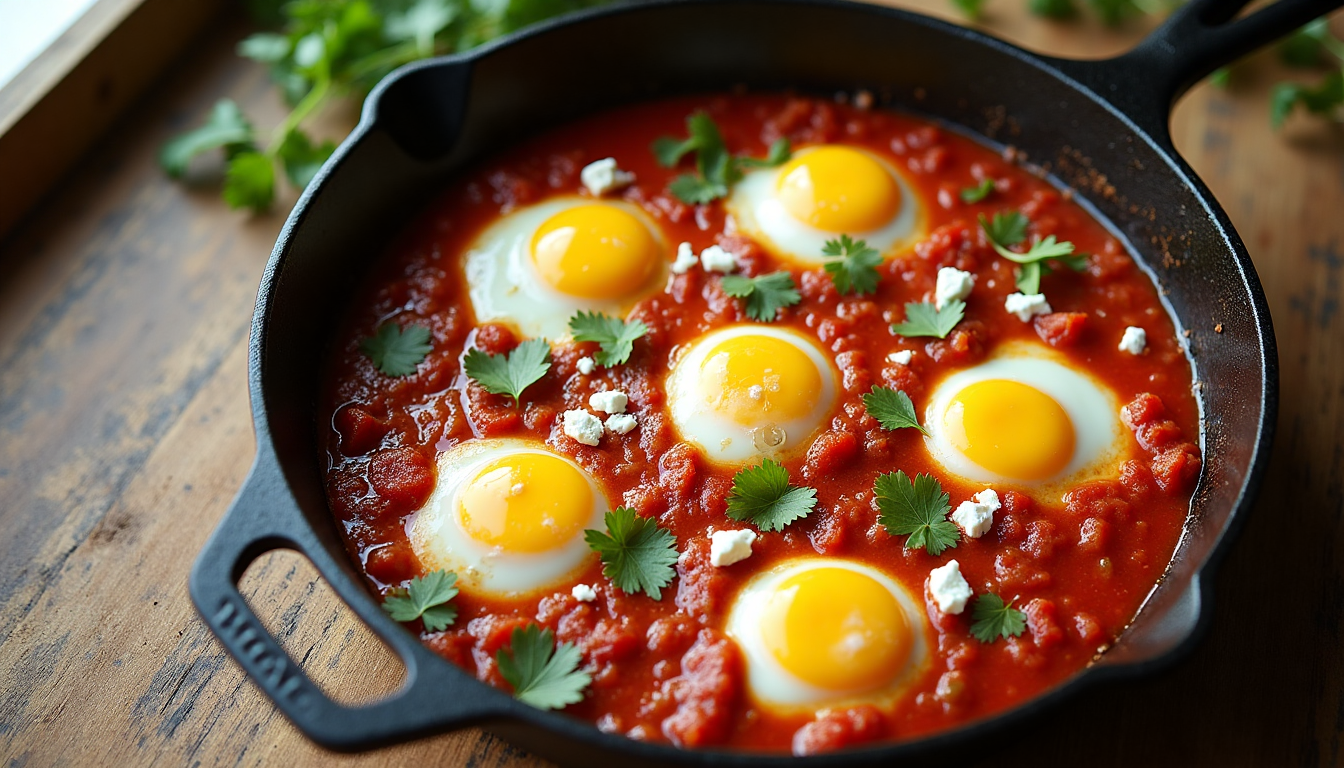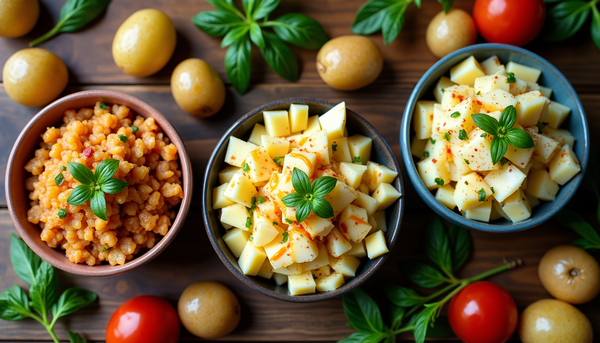The Shakshuka Epiphany: Why This One-Pan Wonder Changed My Entire Approach to Cooking

The Shakshuka Epiphany: Why This One-Pan Wonder Changed My Entire Approach to Cooking
It was 11:47 PM on a Tuesday, and I was staring into my fridge with the kind of existential dread usually reserved for debugging production code. Another 14-hour day, another sad desk salad for lunch, another evening where ordering DoorDash felt both inevitable and soul-crushing.
That's when I spotted them: six eggs, a can of tomatoes that had been judging me from the pantry for weeks, and half an onion wrapped in plastic like a forgotten promise. I'd heard about shakshuka before—seen those gorgeous Instagram shots of eggs nestled in bubbling red sauce—but honestly? I'd always assumed it was one of those dishes that looked simple but required some secret Middle Eastern grandmother magic I definitely didn't possess.
Spoiler alert: I was completely wrong. And that night changed everything.
First Things First: Let's Talk About Respect
Before we dive into the good stuff, real talk—shakshuka isn't just some trendy brunch dish that materialized on Pinterest. This is a beloved staple across North Africa and the Middle East, with deep cultural roots and countless regional variations. Tunisia, Israel, Palestine, Morocco—every culture has its own relationship with this dish, and that's not something I take lightly.
I'm not here to "elevate" or "reinvent" shakshuka (ugh, I hate when food writers do that). What I want to share is what this dish taught me about technique, about patience, and about how the most profound comfort foods are often the simplest ones. Plus, you know, how to make it absolutely perfectly every single time.
The Science of Why Shakshuka Just... Works
Here's what blew my mind that first night: shakshuka is basically a masterclass in layered flavor development, disguised as a humble eggs-and-tomatoes situation. It's like the food equivalent of elegant code—simple on the surface, but every element serves multiple purposes.
The Foundation Layer: You start with aromatics—onions, garlic, maybe some bell pepper. This isn't just about adding flavor; you're creating the base layer of sweetness and complexity that'll carry the entire dish. When you properly sweat those onions (and yes, there's a difference between sweating and sautéing, fight me), you're breaking down cellular structures and concentrating sugars. It's chemistry, people.
The Spice Bloom: Then comes the moment that separates good cooks from great ones—blooming your spices in the oil. Cumin, smoked paprika, maybe some red pepper flakes. Those spices need fat and heat to release their full potential. Skip this step and your shakshuka will taste... fine. Do this right and suddenly you've got depth that makes people wonder what your secret is.
The Tomato Situation: Here's where most people mess up. You dump in those canned tomatoes (and please, for the love of all that is holy, use good canned tomatoes—it's literally half your dish), and you think you're done. Nope. That sauce needs to reduce. It needs to concentrate. It needs to become thick enough to hold those eggs in their little wells without them sliding around like they're on an ice rink.
The Egg Magic: And finally, the eggs. This isn't scrambled eggs, it's not a frittata, it's poached eggs in sauce. You want those whites set but those yolks still jammy, so when you break into them, you get this incredible richness that mixes with the tomato sauce and creates something that's greater than the sum of its parts.
My Method (AKA What Actually Works When You're Tired and Hungry)
Okay, enough theory. Let's make this thing.
What You Actually Need:
- 2 tablespoons olive oil (not your fancy finishing oil, just regular good olive oil)
- 1 medium onion, diced (I never measure this precisely and neither should you)
- 1 red bell pepper, diced (adds sweetness and color, non-negotiable)
- 4 cloves garlic, minced (or more, I'm not your boss)
- 1½ teaspoons each: cumin and smoked paprika (seriously, don't skip the smoked paprika)
- ¼ teaspoon red pepper flakes (adjust for your spice tolerance)
- 1 can (28 oz) whole tomatoes with their juices (I prefer whole because I like controlling the texture)
- Salt and black pepper (taste as you go)
- 6 large eggs (room temperature if you remember, but don't stress if you forget)
- 3 oz feta cheese, crumbled (the good stuff, not the pre-crumbled sawdust)
- Fresh cilantro or parsley for garnish
The Process:
Step 1: Get Your Mise Together This isn't fancy French cooking, but trust me—dice everything before you start. When you're cooking after a long day, the last thing you want is to be frantically mincing garlic while your onions burn. Been there, cursed loudly about it.
Step 2: Build Your Base Heat that oil in your widest, shallowest pan. Cast iron is ideal, but honestly, whatever large skillet you have will work. Add the onions and bell pepper—they should sizzle but not scream. If they're screaming, your heat's too high. We're going for that gentle bubble, the kind that says "I'm working but I'm not stressed about it."
Cook these for about 5 minutes, stirring occasionally. You want them softened and starting to caramelize. Your kitchen should smell amazing right about now.
Step 3: The Aromatics Hit Add your garlic and spices. This is where you need to pay attention—garlic can go from perfect to burnt in about 30 seconds, and burnt garlic is the enemy of happiness. Stir constantly for about 1-2 minutes until everything smells toasted and warm.
Step 4: Tomato Time Here's where it gets a little chaotic—add those tomatoes with their juices. The liquid might splatter (seriously, be careful), so you can turn the heat down slightly before you add them.
Now comes the fun part: use your wooden spoon to break up those whole tomatoes. Don't be gentle. Crush them into chunky pieces. It's weirdly therapeutic after a stressful day.
Let this whole situation come to a simmer, then dial it back to medium-low. You want a gentle bubble, not a volcanic eruption. Now we wait. This is the hardest part for Type A personalities like me, but the sauce needs 5-10 minutes to reduce and thicken. Go make yourself a drink. Answer some texts. Just let it do its thing.
Step 5: The Egg Moment Your sauce should now be thick enough to support eggs without them sliding into the center like they're in a tomato soup pool. Using your spoon, create little wells in the sauce—6 indentations where your eggs will live.
Crack each egg into a small bowl first (trust me on this), then gently pour it into a well. This gives you control and prevents any shell disasters. Sprinkle about half your feta over everything.
Cover the pan and let it cook for 3-4 minutes for runny yolks, or 5-6 if you prefer them more set. This timing can vary wildly based on your pan, your stove, your altitude, the phase of the moon... so keep checking.
Step 6: The Finish Line Once your eggs are done to your liking, remove the lid with a flourish (because you've earned it). Sprinkle the remaining feta and a generous handful of fresh herbs over everything. The contrast of cool, bright herbs against the warm, rich sauce is chef's kiss.
Where I Take Creative Liberties (Respectfully)
The beautiful thing about shakshuka is how adaptable it is. Once you nail the basic technique, you can riff on it endlessly. Here are some variations I've fallen in love with:
The Protein Boost: Sometimes I'll brown some spicy merguez or chorizo before adding the vegetables. The rendered fat becomes part of the base, and the spiced meat adds another layer of complexity.
The Green Goddess: Wilted spinach or torn kale stirred in just before adding the eggs turns this into something that feels virtuous enough for Sunday morning.
The Umami Bomb: A tablespoon of harissa paste (if you can find it) or even a splash of fish sauce adds depth that'll make you question everything you thought you knew about tomato sauce.
The Brunch Remix: Sometimes I'll make individual portions in small cast iron skillets. It's a little extra, but perfect for when you want to impress someone without actually putting in that much effort.
The Cultural Fusion Question
Look, I know fusion can be a loaded term, especially when we're talking about traditional dishes from cultures that aren't our own. But here's how I think about it: understanding a dish well enough to play with it respectfully requires really learning it first.
I spent months making traditional shakshuka, reading about its history, understanding why each ingredient is there. Only then did I feel comfortable experimenting. And even now, I always come back to the original—because sometimes the traditional way is traditional for a reason.
If you want to try your own variations, do the work first. Make it the classic way multiple times. Understand what each element contributes. Then, when you do experiment, you'll be building on a foundation of respect and knowledge, not just throwing random ingredients together because you think you can "improve" a dish that's been perfected over generations.
Why This Matters More Than Just Dinner
Here's the thing about shakshuka that took me way too long to realize: it's not just about the food. It's about slowing down. It's about working with time instead of against it. It's about creating something beautiful and nourishing even when you're exhausted.
In my world of instant everything—instant messages, instant deploys, instant gratification—there's something almost revolutionary about a dish that requires you to wait. To let onions caramelize slowly. To let sauce reduce properly. To watch eggs cook in real time.
That first night, standing in my kitchen at almost midnight, watching those egg whites slowly set in their little tomato nests, I realized I'd been approaching cooking all wrong. I'd been treating it like another task to optimize, another problem to solve as quickly as possible. But shakshuka taught me that some things are supposed to take time. Some things are actually better when you can't rush them.
Your Mission, Should You Choose to Accept It
So here's what I want you to do: make this dish. Not just follow the recipe, but really make it. Pay attention to how the onions smell when they're properly softened. Notice how the spices bloom and become fragrant when they hit the hot oil. Watch the sauce reduce and thicken. Observe how the eggs slowly cook in their little wells.
And then, tell me about it. What did you notice? What went differently than you expected? Did you burn the garlic the first time? (I did.) Did you crack an egg directly into the pan and immediately regret it? (Also did that.)
Food is meant to be shared—not just the eating, but the making, the learning, the inevitable kitchen disasters that turn into funny stories later. Shakshuka is the perfect dish for building confidence, for understanding technique, and for creating something that feels like a warm hug after a long day.
Plus, it's basically impossible to mess up so badly that it's not delicious. Even my first, slightly burnt, underseasoned attempt was better than takeout. And by the fifth time? I was making shakshuka that had my friends asking for the recipe.
Start with respect. Build on tradition. Make it your own when you're ready. And always, always make extra—because leftover shakshuka (yes, it reheats beautifully) might just be one of life's perfect pleasures.
Now stop reading and go make some dinner. Your future self, standing in front of a bubbling pan of tomato-y, egg-y perfection, will thank you.
What's your favorite one-pan wonder? Drop a comment and let me know what dishes have changed your approach to cooking. I'm always looking for my next culinary obsession.




